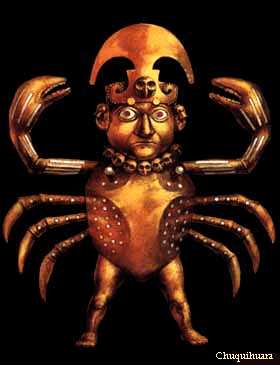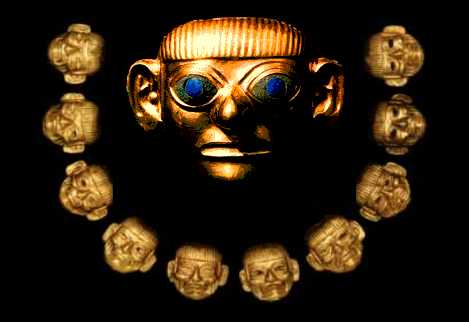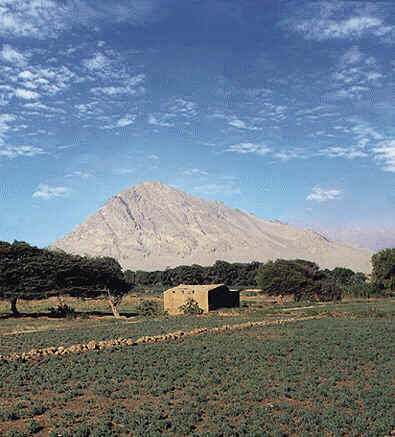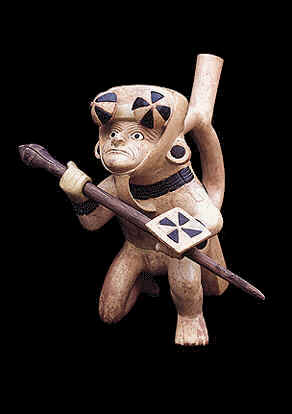The Moche and Chimu cultures left the greatest mark on the Trujillo area,
but are by no means the
only ones as over 2000 sites in the Moche River valley. Many of these sites
are small and nearly
forgotten, but others include the largest pre-Colombian city in America
(Chan Chan) as well  as
as
pyramids which required in excess of an incredible 100 million adobe bricks
to construct. Five
major archaeological sites can be easily reached from Trujillo by local
bus or taxi. Two of these
sites are Moche, dating from about 500 AD. The other three, from the Chimu
culture, date from
about 1200 AD to 1300 AD
The fascinating Moche period begins with the decline of the Cupisnique
period at about the time of Christ.The Moche didn't conquer the Cupisnique;
rather, there was a slow transition
characterized by a number of developments. Ceramics, textiles and metalwork
improved `greatly, architectural skills allowed the construction of huge
pyramids and other structures and there was enough leisure tune for art
and a highly organized religion. The Moche culture, a culture that has left
impressive archaeological sites and some of the most outstanding pottery
to be seen in Peru's museums, is named after the river which flows into
the ocean just south of Trujillo. The word Mochica has been used interchangeably
with Moche and refers to a
dialect spoken in the Trujillo area at the time of the conquest, though
not necessarily spoken by the Moche people. Moche is now the preferred usage.
As with the Nazca culture, which developed on the south coast at about
the same time, the Moche period is especially known for its ceramics, considered
the most artistically sensitive and technically developed of any found in
Peru. The thousands of Moche pots preserved in museums are so realistically
decorated with figures and scenes that they give us a very
descriptive look at life during the Moche period. Pots were modeled into
lifelike representations of people, crops, domestic or wild animals, marine
life and houses. Other pots were painted with scenes of both ceremonial
and everyday life. From these pots, archaeologists know that Moche society
was very class conscious.
The most important people, especially the priests and warriors, were members of the urban classes and lived closest to the large ceremonial pyramids and other temples. They were surrounded by a middle class of artisans and then, in descending order: farmers and fishermen, servants, slaves and beggars. The priests and warriors were both honored and obeyed. They are the people most frequently shown in ceramics, which depict them being carried in litters wearing particularly fine jewelry or clothing. Their authority is evident from pots showing scenes of punishment, including the mutilation and death of those who dared to disobey. Other facets of Moche life illustrated on the pots include surgical procedures such as amputation and setting of broken limbs. Sex is realistically shown; one room in the Rafael Herrera Museum in Lima is entirely devoted to (mainly Moche) erotic pots depicting most sexual practices, some rather imaginative. Clothing, musical instruments, tools and jewelry are all frequent subjects for ceramics. As there was no written language, most of what we know about the Moche comes from this wealth of pottery. The ceramics also show us that the Moche had well-developed weaving techniques but, because of rare rainstorms every few decades, most of their textiles have been destroyed. Metalwork, on the other hand, has survived. They used gold, silver and copper mainly for ornaments but some heavy copper implements have also been found.
The Moche did not live in towns as we know them. A more accurate description
would be a
high-density peasant population surrounding a central worship site such
as a massive pyramid. Two of these survive, side by side, a few km south
of Trujillo. They are known as the Huacas del Sol y de la Luna, or the 'Temples
of the Sun and the Moon', and are easily visited. The Temple of the Sun
is the largest pre-Colombian structure in South America
![]()
 " The Ulluchu Man ". The size of a crab deity astound everybody.
With the head and legs of a human and the caparace, legs, and claws of a
crab, the gilded gold piece is more than two feet tall. This enigmatic figure
with raised arms was once mounted on a fabric banner covered with gilded
metal plates. We call him Ulluchu Man,
" The Ulluchu Man ". The size of a crab deity astound everybody.
With the head and legs of a human and the caparace, legs, and claws of a
crab, the gilded gold piece is more than two feet tall. This enigmatic figure
with raised arms was once mounted on a fabric banner covered with gilded
metal plates. We call him Ulluchu Man,
because the banner yielded some of the first samples of this ancient fruit
yet discovered. The ulluchu is laden with symbolism, usually appearing in
scenes relating to war and the ritual drinking of a prisoner's blood. One
Theory suggests that the ulluchu is part of the papaya family and has anticoagulant
properties, useful to
forestall clotting before a man's blood was
consumed. That such bloody business would go hand in hand with masterpieces
in metal and clay remains a piece of the puzzle of the mysterious Moche.

Shining with the sunlight a gold human head, broadfaced like an infant's,
returns everybody
stare with haunting and heavy - lidded eyes of silver and cobalt pupils
of lapis lazuli . Gold
human heads almost 3 inches high, that were once linked to form an invaluable
gorgeous
necklace for the tomb's royal occupant, reveal a remarkable Master works
of Art of the
amazing Moches.

